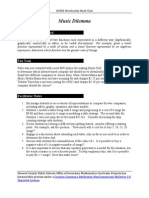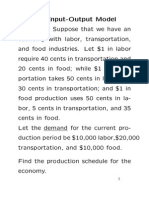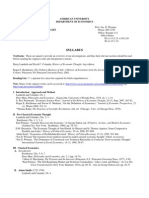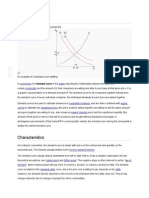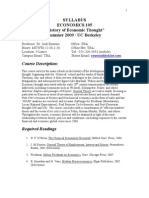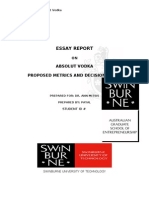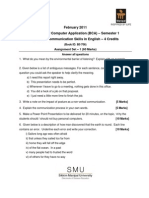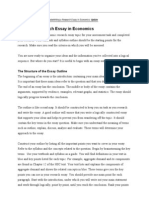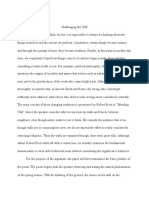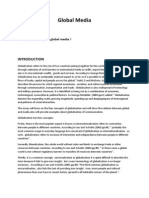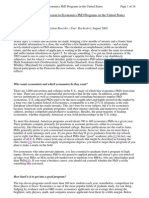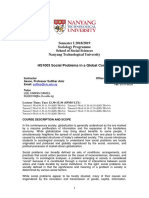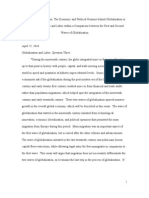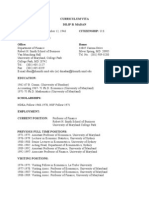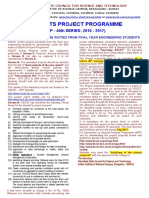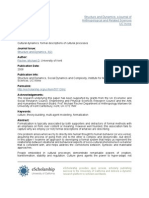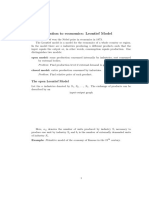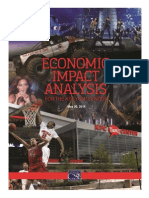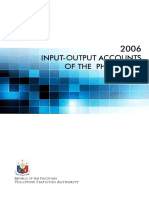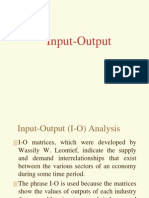Advance Heterodox Economics - Lectures On Production
Advance Heterodox Economics - Lectures On Production
Uploaded by
oscrend39Copyright:
Available Formats
Advance Heterodox Economics - Lectures On Production
Advance Heterodox Economics - Lectures On Production
Uploaded by
oscrend39Original Description:
Original Title
Copyright
Available Formats
Share this document
Did you find this document useful?
Is this content inappropriate?
Copyright:
Available Formats
Advance Heterodox Economics - Lectures On Production
Advance Heterodox Economics - Lectures On Production
Uploaded by
oscrend39Copyright:
Available Formats
1
ADVANCED HETERODOX ECONOMICS (ECON 5503) Fall 2012
Professor F. S. Lee Office: Manheim Hall 202D Office Hours: MW 10.00-11.00 or by appt. E-mail: leefs@umkc.edu Tel.: 816-235-2543
Lectures: Required Texts:
Wednesday, 1.00 3.45p.m., Royall Hall 204 L. L. Pasinetti, Lectures on the Theory of Production. R. Miller and P. Blair, Input-Output Analysis W. Leontief, The Structure of American Economy, 1919 1939 P. Sraffa, Production of Commodities by Means of Commodities. F. S. Lee, The Simple Mathematics of Linear Production Models. F. S. Lee (ed.), Social Provisioning, Embeddedness, and Modeling the Economy H. D. Kurz and N. Salvadori, Theory of Production: A Long Period Analysis A. Sinha, Theories of Value from Adam Smith to Piero Sraffa G. Chiodi and L. Ditta (eds) Sraffa or an Alternative Economics L. L. Pasinetti, Keynes and the Cambridge Keynesians Take home exam handed out on September 19, 2012 and returned on September 26, 2012worth 25% of your final grade Take home exam handed out on October 24, 2012 and returned on October 31, 2012worth 25% of your final grade Take home exam handed out on November 28, 2012 and returned on December 5, 2012worth 25% of your final grade. Final Exam, December 12, 2012, 1.00-3.00pmworth 25% of your final grade There will be no class on December 5, 2012it will be rescheduled for another day. It will be distribute and placed on Blackboard. The course examines various theoretical approaches and topics, both historically and currently, that constitute heterodox economics. In particular, the course deals in depth with the mathematical and economic properties of heterodox production and price models. After reviewing the mathematics of linear production-price models, the module will examine Leontief, Sraffian, and other heterodox price and production models.
Optional Texts:
Assessment:
Announcement: Problem Set: Description:
"This link will direct you to essential information regarding university policies, rules, and resources http://cas.umkc.edu/student-resources.asp "
Here are some great resources to help students build their math skills. The Khan Academy: http://www.khanacademy.org/math/algebra I've linked to the algebra section of this site, but there are short tutorials at all levels of math. I highly recommend to my students that they watch some of these in the algebra section, especially if they aren't solid on what a function is and why we are using them in economics. There are also some tutorials on graphing equations and such. Geogrebra: http://www.geogebra.org/cms/ This one is a very nice tool for graphing functions and playing around with them. You can run it in the browser or simply download a standalone version.
COURSE OUTLINE I. Introduction A. B. Production as a Circular Process and the Foundation of Heterodox Economics Brief Historical Excursus 1. 2. 3. 4. 5. Miller and Blair, Input-Output Analysis, Appendix C. Kurz, H. D. and Salvadori, N. 2000. Classical Roots of Input-Output Analysis: A Short Account of its Long Prehistory. Economic Systems Research 12.2: 153 179. Walsh, V. and Gram, H. Classical and Neoclassical Theories of General Equilibrium, chs. 1-4. Langer, G. F. 1988. Corn: A Classical Landscape. Economic Notes 17.1: 5 21. Ricardo, D. 1815. "An Essay on the Influence of a Low Price of Corn on the Profit of Stock." In Pamphlets and Papers, 1815 - 1823, Vol. 4, The Works and Correspondence of David Ricardo, pp. 1 - 42. Edited by P. Sraffa. Cambridge: Cambridge University Press, 1966. Gehrke, C. 2003. Alfred Kahler: A Pioneer of Input-Output Analysis. Unpublished. Kurz, H. D. 2011. Who is Going to Kiss Thorn Rose? On the Classical
6. 7.
Analytical Origins and Perspectives of Input-Output Analysis, Review of Political Economy 23.1: 25 47. II. A. Input-Output Modelling of the Economy Input-Output Representation of the Economy 1. 2. 3. 4. B. Miller and Blair, Input-Output Analysis, ch. 4.1-4.6 K. J. Horowitz and M. A. Planting, Concepts and Methods of the U.S. Input-Output Accounts, http://www.bea.gov/papers/pdf/IOmanual_092906.pdf, chs. 1 6, 12. US input-output tables can be found at http://www.bea.gov. Also see http://www.bls.gov/home.htm; http://www.census.gov/wholesale/index.html. Rose, W. and Miernyk, W. 1989. Input-Output Analysis: The First Fifty Years. Economic Systems Research, 1.2: 229-271.
The Simple Mathematics of Linear Production and Price Models 1. 2. 3. 4. 5. 6. 7. 8. Lee, F. S. "The Simple Mathematics of Linear Production Models". Pasinetti, Lectures on the Theory of Production, pp. 226 276. Miller and Blair, Input-Output Analysis, Appendix A. Kurz and Salvadori, Theory of Production, Mathematical appendix Takayama, A. 1974. Mathematical Economics. Hinsdale: The Dryden Press, pp. 359 - 391. Solow, R. 1952. "On the Structure of Linear Models," Econometrica 20.1 (January): 29 - 46. http://links.jstor.org/sici?sici=00129682%28195201%2920%3A1%3C29%3AOTSOLM%3E2.0.CO%3B2-3 Faddeeva, V. N. 1959. Computational Methods of Linear Algebra. New York: Dover Publications, Inc., pp. 117 - 127. Nikaido, H. 1968. Convex Structures and Economic Theory. New York City: Academic Press, pp. 87 108.
C.
Closed and Open Leontief Models 1. 2. 3. 4. 5. Pasinetti, Lectures, pp. 35 - 70. W. Leontief, The Structure of American Economy, 1919 - 1939. Miller and Blair, Input-Output Analysis, chs. 2, 5, 6 Schwartz, J. T. 1961. Lectures on the Mathematical Method in Analytical Economics. New York: Gordon and Breach, chs. 1 4. Leontief, W. Input-Output Economics.
D.
Social Accounting Matrices and other Special Topics 1. Miller and Blair, Input-Output Analysis, chs. 9-11.
2. III.
Miyazawa, K. and Masegi, S. 1963. Interindustry Analysis and the Structure of Income-Distribution. Metroeconomica, 15: 89 103.
Sraffian Production-Price Models A. Sraffas Production-Price Model 1. 2. 3. 4. 5. 6. 7. 8. 9. B. R. L. Meek, "Mr. Sraffa's Rehabilitation of Classical Economics," Scottish Journal of Political Economy 8 (1961), pp. 119 - 136. Pasinetti, Keynes and the Cambridge Keynesians, Book II. Kurz and Salvadori, Theory of Production, chs. 1 and 13. Aspromourgos, T. 2004. Sraffian Research Programmes and Unorthodox Economics. Review of Political Economy 16.2 (April): 179 206. Kurz, H. D. and Salvadori, N. 2005. Representing the Production and Circulation of Commodities in Material Terms: On Sraffas Objectivism. Review of Political Economy 17.3 (July): 413 - 441. Kurz, H. D. and Salvadori, N. 2006. Input-Output Analysis from a Wider Perspective: A Comparison of the Early Works of Leontief and Sraffa. Economic Systems Research 18.4 (December): 373 390. Sinha, Theories of Value from Adam Smith to Piero Sraffa, ch. 4: 277-281, 310 - 332. Kurz, H. B. 2006. The Agent of Production are the Commodities Themselves: On the Classical Theory of Production, Distribution and Value. Structural Change and Economic Dynamics 17: 1 26. Chiodi and Ditta, Sraffa or Alternative Economics, chs. 3, 4, 5, 7, 14.
Production for Subsistence and the Price System 1. 2. Sraffa, Production of Commodities, pp. 3 - 5. Pasinetti, Lectures, pp. 71 - 73.
C.
Production with a Surplus and the Price System 1. 2. 3. 4. 5. Sraffa, Production of Commodities, pp. 6 - 11. Pasinetti, Lectures, pp. 71 - 73. Kurz and Salvadori, Theory of Production, chs. 3 and 4. Harris, D. 1981. On Timing of Wage Payments. Cambridge Journal of Economics 5: 369 382. Sinha, Theories of Value from Adam Smith to Piero Sraffa, ch. 4: 281 294.
D.
Prices, Wages, and the Rate of Profit: the relationship between relative prices and the rate of profit 1. Sraffa, Production of Commodities, pp. 12 - 17.
2. E.
Pasinetti, Lectures, pp. 74 - 84.
Prices, Wages, and the Rate of Profit: the relationship between the wage rate and the rate of profit 1. 2. 3. 4. Sraffa, Production of Commodities, pp. 34 - 40 and 81 - 87. Pasinetti, Lectures, pp. 84 - 92 and 151 - 167. Kurz and Salvadori, Theory of Production, chs. 3, 4. Sinha, Theories of Value from Adam Smith to Piero Sraffa, ch. 4: 295 297.
F.
The Rate of Profit and Non-Basic Commodities 1. 2. Sraffa, Production of Commodities, 90 - 91. Pasinetti, Lectures, pp. 104 - 111.
IV.
Alternative Heterodox Production and Price Models A. The Classical Production-Price Model 1. 2. 3. 4. Clark, D. 1984. "Confronting the Linear Imperialism of the Austrians." Eastern Economic Journal 10 (April-June): 107 - 127. Ricardo, D. 1821. On the Principles of Political Economy and Taxation, Vol. 1, The Works and Correspondence of David Ricardo, ch. 1. Edited by P. Sraffa. Cambridge: Cambridge University Press, 1975. Pasinetti, L. L. 1981. "The Rate of Interest and the Distribution of Income in a Pure Labor Economy." Journal of Post Keynesian Economics 3 (Winter): 170 - 182. Dmitriev, V. 1974. V. K. Dmitriev: Economic Essays on Value, Competition and Utility. Edited by D. M. Nuti. London: Cambridge University Press, pp. 39 - 80.
B.
The Burchardt Production-Price Model 1. 2. Nurske, R. 1935. "The Schematic Representation of the Structure of Production," Review of Economic Studies 2 (June): 232 - 244. Kalecki, M. 1954. Theory of Economic Dynamics: An Essay on Cyclical and Long-Run Changes in Capitalist Economy. In Collected Works of Michal Kalecki, Vol. 2, Capitalism: Economic Dynamics, pp. 205 - 348. Edited by O. Osiatynski. Oxford: Clarendon Press. Kregel, J. A. 1975. The Reconstruction of Political Economy: An Introduction to Post-Keynesian Economics. 2nd. ed. London: The Macmillan Press, chs. 1 - 8. Harris, D. J. 1974. "The Price Policy of Firms, the Level of Employment and Distribution of Income in the Short Run." Australian Economic Papers 13 (June): 144 - 151. Asimakopulos, A. 1975. "A Kaleckian Theory of Income Distribution,"
3. 4. 5.
6. 7. 8. 9.
Canadian Journal of Economics 8 (August): 313 - 333. Robinson, J. 1956. The Accumulation of Capital. London: Macmillan, chs. 7 - 22. Kaldor, N. 1955. "Alternative Theories of Distribution." Review of Economic Studies 23 (March): 83 - 100. Lee, F. S. 1998. Post Keynesian Price Theory. Cambridge: Cambridge University Press, ch. 7. Harcourt, G. C. 1965. "A Two-Sector Model of the Distribution of Income and the Level of Employment in the Short Run." Economic Record 41 (March): 103 - 117.
C.
The Lowe Production-Price Model 1. 2. 3. 4. Lowe, A. 1952. "A Structural Model of Production," Social Research 19 (June): 135 - 176. Clark, D. 1984. Confronting the Linear Imperialism of the Austrians: Lowes Contribution to Capital and Growth Theory. Eastern Economic Journal 10.2: 107 27. Lowe, A. 1976. The Path of Economic Growth. Cambridge: Cambridge University Press, ch.s. 1-7. Hagemann, H. and Kurz, H. D. 1998. Political Economics in Retrospect: Essays in Memory of Adolph Lowe. Cheltenham: Edward Elgar, ch. 6.
D.
Pasinetti and the Modeling of Structural Change 1.
2.
3. 4. 5.
Pasinetti, L. L. 1993. Structural Economic Dynamics: A Theory of the Economic Consequences of Human Learning. Cambridge: Cambridge University Press, ch. 2. Pasinetti, L. L. 1988. Growing Subsystems, Vertically Hyper-Integrated Sectors and the Labour Theory of Value. Cambridge Journal of Economics 12: 125 134. Trigg, A. B. and Lee, F. S. 2005. Pasinetti, Keynes and the Multiplier. Review of Political Economy 17.1: 29 43. Pasinetti, Keynes and the Cambridge Keynesians, Books I and III. Pasinetti, L. L. 1981. Structural Change and Economics Growth: A theoretical essay on the dynamics of the wealth of nations. Cambridge: Cambridge University Press, ch. 1 2.
E.
Bortis and Classical-Keynesian Modeling of the Economy 1. 2. Bortis, H. 2003. Keynes and the Classics: Notes on the Monetary Theory of Production. In Modern Theories of Money, 411 474. Edited by L.-P. Bortis, H. 2012. Shackles Years of High Theory 1926-1939 [- 1960] and the Making of Classical-Keynesian Political Economy: From the Exchange Paradigm to a Monetary Theory of Production.
3. 4. V.
von Ah, A. 2012. Institutions and the Long-Period Theory and Policy of Employment. von Ah, A. 2010. Sraffa and the Long-Period Theory of Employment.
Heterodox Production and Price Models A. Modeling the Economy 1. 2. 3. B. Miller and Blair, Input-Output Analysis, ch. 11. Lee, F. S. 1998. Post Keynesian Price Theory. Cambridge: Cambridge University Press, ch. 12. Lee, Social Provisioning, Embeddedness, and Modeling the Economy, chs. 1, 8.
Agency, Prices, Output, and Employment 1. Lee, F. S. 1998. Post Keynesian Price Theory. Cambridge: Cambridge University Press, ch. 12.
C.
Modeling the Core of the Economy 1. Lee, F. S. 2012. Post-Keynesian price theory: from pricing to market governance to the economy as a whole, in G. C. Harcourt and P. Kriesler (eds.) Handbook of Post-Keynesian Economics, Oxford: Oxford University Press.
D.
Special Analytical Topics 1. 2. 3. Chiodi, G. 1992. On Sraffas Notion of Viability. Studi Economica 46:5 23. Chiodi, G. 1998. On Non-Self-Replacing States. Metroeconomica 29.1: 97 107. Chiodi, G. 2010. The Means of Subsistence and the Notion of Viability in Sraffas Surplus Approach. In S. Zambelli (ed.) Computable, Constructive and Behavioural Economic Dynamics, 318 330. De Gregori, T. R. (1987) Resources are not: they become: an Institutional theory, Journal of Economic Issues, 21, pp. 12411263.
4. VI.
Conclusion: comparing and evaluating the heterodox production and price models A. Schema of Production, Circular Production, and Input-Output Heterogeneity 1. Pasinetti, L. L. 1986. Sraffas Circular Process and the Concept of Vertical Integration. Political Economy: Studies in the Surplus Approach 2: 3 16.
2. 3. 4. 5. 6. 7.
M. C. Howard, "Austrian Capital Theory: An Evaluation in Terms of Piero Sraffa's Production of Commodities by Means of Commodities," Metroeconomica 32 (1980), pp. 1 - 23. Gaitskell, H. T. N. 1936. "Notes on the Period of Production - Part I." Zeitschrift fur Nationalokonomie 7 (December): 577 - 595. Gaitskell, H. T. N. 1938. Notes on the Period of Production Part II. Zeitschrift fur Nationalokonomie 9 (July): 215 244. Leontief, W. 1991. The Economy as a Circular Flow. Structural Change and Economic Dynamics 2.1: 181 212. Kurz and Salvadori, Theory of Production, ch. 13. Gehrke, C. and Kurz, H. D. 2006. Sraffa on von Bortkiewicz: Reconstructing the classical theory of value and distribution. History of Political Economy 38.1: 91 149.
B.
Prices, Profits, and Income Distribution 1. 2. 3. 4. 5. DOrlando, F. 2007. A Methodological Note on Long-Period Positions. Contributions to Political Economy 26: 17 26. Sinha, Theories of Value from Adam Smith to Piero Sraffa, ch. 4: 321 330. F. S. Lee, Full Cost Prices, Classical Price Theory, and Long Period Method Analysis: A Critical Evaluation, Metroeconomica 37 (1985), pp. 199 219. I. Steedman, "Questions for Kaleckians," Review of Political Economy 4 (1992) pp. 125 - 151. Trigg, A. (2008) Quantity and price systems: toward a framework for coherence between Post-Keynesian and Sraffian economics, in J. T. Harvey and R. F. Garnett (eds.), Future Directions for Heterodox Economics, Ann Arbor: The University of Michigan Press. Lee, Social Provisioning, Embeddedness, and Modeling the Economy, ch. 3. DOlrando, F. (2005) Will the classical-type approach survive Sraffian theory?, Journal of Post Keynesian Economics, 27: 633-654.
6. 7. C.
Agency, Surplus, and the Coordination of Economic 1. 2. 3. 4. Pasinetti, L. L. (1997) The principle of effective demand, in G. C Harcout and P. A. Riach (eds.) A Second Edition of The General Theory, London: Routledge. Pasinetti, L. L. (2001) The principle of effective demand and its relevance in the long run, Journal of Post Keynesian Economics, 23: 383-390. Pasinetti, L. L. (2005) From pure theory to full economic analysisa place for the economic agent, Cachiers d'conomie Politique, 2: 211-216. Lee, F. S. and Jo, T.-H. (2011) Social surplus approach and heterodox economics, Journal of Economic Issues, 45: 857-875.
D. E.
Aggregation, State and other Institutions Multiplier 1. 2. Serrano, F. L. P. (1995a) The Sraffian Supermultiplier, PhD diss., St. Edmunds College, University of Cambridge. Serrano, F. L. P. (1995b) Long period effective demand and the Sraffian supermultiplier, Contributions to Political Economy, 14: 67-90.
F.
Organizing Theorizing: Non-Equilibrium vs. Equilibrium 1. 2. Sinha, A. and Dupertuis, M.-S. 2009. Sraffa and the Question of Equilibrium, Cahiers dEconomie Politique, 56: 91 100. Sinha, A. 2012. Sraffas Theory: A Theory of Value without the Notion of Equilibrium.
You might also like
- Solution of Linear System Theory and Design 3ed For Chi-Tsong ChenDocument106 pagesSolution of Linear System Theory and Design 3ed For Chi-Tsong ChenQingyu Meng89% (19)
- Implan Pro Manual v2 3rd EditionDocument438 pagesImplan Pro Manual v2 3rd EditionTimroo HamroNo ratings yet
- Essay Chp7Document8 pagesEssay Chp7barrettm82a1No ratings yet
- Economics Coursework Essay Report (UMEDKL-30-0) - 20020418 - Mohamed SannehDocument4 pagesEconomics Coursework Essay Report (UMEDKL-30-0) - 20020418 - Mohamed SannehfatouNo ratings yet
- Scope and Methods in Economics Harrod Roy-Páginas-1-16Document16 pagesScope and Methods in Economics Harrod Roy-Páginas-1-16genarospNo ratings yet
- Basic Principles of GlobalizationDocument10 pagesBasic Principles of GlobalizationBarbara Zuñiga EscalanteNo ratings yet
- FNCE401v7 Assignment 1Document8 pagesFNCE401v7 Assignment 1David Eaton50% (2)
- Math Music AssignmentDocument4 pagesMath Music Assignment814483019100% (1)
- Marketing Assignment Chapter 5Document5 pagesMarketing Assignment Chapter 5zeeocracy86% (7)
- Contribuciones de Leontief A La EconomíaDocument24 pagesContribuciones de Leontief A La EconomíaMargarita SepulvedaNo ratings yet
- Leontief 1Document24 pagesLeontief 1Tara BhusalNo ratings yet
- Economic Assessment of The Atlantic Coast Horseshoe Crab FisheryDocument73 pagesEconomic Assessment of The Atlantic Coast Horseshoe Crab Fisherynur_azman_26No ratings yet
- History of Economics Thought WismanDocument4 pagesHistory of Economics Thought WismanMarcos BrzowskiNo ratings yet
- MA Economics (Credit Based) Syllabus. Mumbai University Semester 1 and 2Document13 pagesMA Economics (Credit Based) Syllabus. Mumbai University Semester 1 and 2navagatNo ratings yet
- Economics Syllabus PDFDocument10 pagesEconomics Syllabus PDFNolram LeuqarNo ratings yet
- Class Nature of Globalization...Document17 pagesClass Nature of Globalization...Mahtab MahboobNo ratings yet
- Demand Curve: CharacteristicsDocument29 pagesDemand Curve: CharacteristicsAkhil VsNo ratings yet
- School Essay On GlobalizationDocument10 pagesSchool Essay On GlobalizationCheow Xin YiNo ratings yet
- 9732 - 2011 H2 EconomicsDocument12 pages9732 - 2011 H2 Economicsstudysmart110% (1)
- Factors Behind The Brand Switching in Telecom IndustryDocument20 pagesFactors Behind The Brand Switching in Telecom IndustryRasheeq Rayhan0% (1)
- Assignment TheoryDocument4 pagesAssignment Theorybigevil_151190No ratings yet
- Economics and Business Studies Command Terms For Writing Essays and Other QuestionsDocument4 pagesEconomics and Business Studies Command Terms For Writing Essays and Other QuestionsRei Diaz Apalla100% (1)
- H1 Essay Example (Principles of Marketing)Document4 pagesH1 Essay Example (Principles of Marketing)May TangNo ratings yet
- Formulating Segmentation Targeting and Positioning StrategiesDocument15 pagesFormulating Segmentation Targeting and Positioning StrategiesBridgestone55100% (1)
- Marketing EssayDocument6 pagesMarketing EssaySara MillsNo ratings yet
- BM629 CW3 Assignment Brief (DL) JMDocument13 pagesBM629 CW3 Assignment Brief (DL) JMArif KhanNo ratings yet
- Economic Factors EssayDocument2 pagesEconomic Factors EssayAnonymous WvthCUNo ratings yet
- Marking Criteria For Essay Questions in EconomicsDocument2 pagesMarking Criteria For Essay Questions in EconomicsjamesNo ratings yet
- SYLLABUS ECONOMICS 105 "History of Economic Thought" Summer 2009Document7 pagesSYLLABUS ECONOMICS 105 "History of Economic Thought" Summer 2009Amy AdamsNo ratings yet
- Absolut Vodka MarketingDocument10 pagesAbsolut Vodka MarketingNihar ShahNo ratings yet
- BC0032 Communication Skills in English-Assignment-Feb-11Document6 pagesBC0032 Communication Skills in English-Assignment-Feb-11Jani Amitkumar100% (1)
- Micro EconomicsDocument1 pageMicro EconomicsGuruKPONo ratings yet
- Assignment ProblemDocument30 pagesAssignment ProblemVineet Kumar0% (1)
- Course Syllabus - The Economics of Cities and Regions 2017-2018Document8 pagesCourse Syllabus - The Economics of Cities and Regions 2017-2018FedeSivakNo ratings yet
- Kentucky Fried Chicken Marketing PlanDocument8 pagesKentucky Fried Chicken Marketing PlanKristen NallanNo ratings yet
- MG2138 Coursework 13 14Document5 pagesMG2138 Coursework 13 14Geng S OlanrawathanaNo ratings yet
- Lean or Agile or Lean and AgileDocument3 pagesLean or Agile or Lean and AgileHakanNo ratings yet
- English EssayDocument7 pagesEnglish EssayVenessaPhangNo ratings yet
- Coca Cola InternshipDocument3 pagesCoca Cola InternshipManik AroraNo ratings yet
- Economics Essay PredictionsDocument4 pagesEconomics Essay PredictionsLSAT PrepNo ratings yet
- How To Write An EssayDocument6 pagesHow To Write An EssayHelen Huynh0% (1)
- Pre Sessional EssayDocument9 pagesPre Sessional EssayYi San LoNo ratings yet
- The Great Gatsby: Essay WritingDocument6 pagesThe Great Gatsby: Essay WritingEmma RyanNo ratings yet
- QA Marketing and Enterprise Module Handbook - June 2016Document9 pagesQA Marketing and Enterprise Module Handbook - June 2016catalina_abrudeanNo ratings yet
- Economics 2150ADocument6 pagesEconomics 2150Akidz-pcNo ratings yet
- Case Study Johnson Johnson Marketing EssayDocument16 pagesCase Study Johnson Johnson Marketing EssayAdamZain788No ratings yet
- UCLA English 91A EssayDocument7 pagesUCLA English 91A EssayBrandon ShihNo ratings yet
- Global Village ESSAY OUTLINESDocument1 pageGlobal Village ESSAY OUTLINESGold ShineNo ratings yet
- AssignmentDocument7 pagesAssignmentnorlizaz72No ratings yet
- Global Global MediaDocument3 pagesGlobal Global MediamichaelNo ratings yet
- AssignmentDocument1 pageAssignmentChege Ambrose0% (2)
- Strategic Resource MNG: Fahad UmarDocument19 pagesStrategic Resource MNG: Fahad UmarKankona Roy100% (1)
- Guide To PHD S in EconomicsDocument18 pagesGuide To PHD S in EconomicsGuo XuNo ratings yet
- International Economics 8th Edition Appleyard Solutions ManualDocument9 pagesInternational Economics 8th Edition Appleyard Solutions Manuala159411610No ratings yet
- Is Your Country Losing Its Identity Because of Globalization EssayDocument2 pagesIs Your Country Losing Its Identity Because of Globalization Essayapi-312329573No ratings yet
- 586-MKTM028 SPSD2 Assignment22016 17Document7 pages586-MKTM028 SPSD2 Assignment22016 17Muhammad Faraz HasanNo ratings yet
- Business Ethics EssayDocument6 pagesBusiness Ethics Essayapi-375666131No ratings yet
- HS1003 1Document6 pagesHS1003 1KellyNo ratings yet
- Effects of Globalization On Japanese Food Culture and Health EssayDocument18 pagesEffects of Globalization On Japanese Food Culture and Health EssayCherise Fuselier83% (6)
- Labor and GlobalizationDocument21 pagesLabor and GlobalizationScott Abel100% (1)
- Dilip Madan's C.V. S2007Document17 pagesDilip Madan's C.V. S2007yinnancyNo ratings yet
- Labor Economics Havard SyllabusDocument31 pagesLabor Economics Havard SyllabusjoydramblesNo ratings yet
- List of BooksDocument92 pagesList of BooksKaran SuriNo ratings yet
- Vernengo M - 7601 001Document6 pagesVernengo M - 7601 001방병화No ratings yet
- Labor Economics - Harvard - SyllabusDocument29 pagesLabor Economics - Harvard - SyllabusAlbert LudiNo ratings yet
- Combinepdf - Input-Output - Cost of CapitalDocument11 pagesCombinepdf - Input-Output - Cost of CapitalNaomi DazaiNo ratings yet
- Matrices (Unit 1)Document109 pagesMatrices (Unit 1)suhaanNo ratings yet
- Modern Inventory ManagementDocument3 pagesModern Inventory ManagementRosa Cata DumiNo ratings yet
- Students Project Programme: (SPP - 40th SERIES: 2016 - 2017)Document12 pagesStudents Project Programme: (SPP - 40th SERIES: 2016 - 2017)mhd yunusNo ratings yet
- The Leontief Open Input - Output ModelDocument3 pagesThe Leontief Open Input - Output ModelNA DO NINo ratings yet
- BUBT Intra-University Programming Contest, Spring 2020 (Junior Division)Document19 pagesBUBT Intra-University Programming Contest, Spring 2020 (Junior Division)Khalid EmonNo ratings yet
- Chapter No.75Document9 pagesChapter No.75Kamal SinghNo ratings yet
- Lesson 1 Input Output AnalysisDocument46 pagesLesson 1 Input Output AnalysisDavaajargal LkhagvaaNo ratings yet
- Linear Models & Matrix AlgebraDocument33 pagesLinear Models & Matrix AlgebraSyed Asim BukhariNo ratings yet
- Wassily Leontief Input-Output ModelDocument4 pagesWassily Leontief Input-Output ModelprasaNo ratings yet
- 2008 - Fischer - Cultural Dynamics - Structure and DynamicsDocument18 pages2008 - Fischer - Cultural Dynamics - Structure and DynamicsMichael Fischer100% (1)
- 15.1. Kitzes, J. - An Introduction To Environmentally-Extended Input-Output AnalysisDocument27 pages15.1. Kitzes, J. - An Introduction To Environmentally-Extended Input-Output AnalysisDiana Toro HernandezNo ratings yet
- National Health PolicyDocument8 pagesNational Health PolicyTanmoy JanaNo ratings yet
- Lecture 21 - Sugeno Fuzzy ModelsDocument5 pagesLecture 21 - Sugeno Fuzzy ModelsAmmar AlkindyNo ratings yet
- A Guided Book of Engineering EconomicsDocument54 pagesA Guided Book of Engineering EconomicsmusaNo ratings yet
- Leontief PDFDocument7 pagesLeontief PDFErvin ArrasyidNo ratings yet
- The Four Dimensions of Public Financial ManagementDocument9 pagesThe Four Dimensions of Public Financial ManagementInternational Consortium on Governmental Financial Management100% (2)
- Basic Premises of Comparative Public AdministrationDocument20 pagesBasic Premises of Comparative Public AdministrationKatarina MeiraNo ratings yet
- KFC YUM Center Report FinalDocument24 pagesKFC YUM Center Report FinalHouseLannister1No ratings yet
- Models of PolicyDocument28 pagesModels of PolicyAnonymous BACdUNvPZ2No ratings yet
- NSCB 2006 - IoDocument235 pagesNSCB 2006 - IoHadji Cortez JalotjotNo ratings yet
- I oDocument18 pagesI oDimas Andi DashNo ratings yet
- 3 Aplication of Matrice Operations (Larson)Document14 pages3 Aplication of Matrice Operations (Larson)Neo Ndo KoNo ratings yet
- Carbon Emission and Tax - Singapore Case (2013)Document23 pagesCarbon Emission and Tax - Singapore Case (2013)Toh Mun HengNo ratings yet
- Bank of Jamaica - ToruismDocument25 pagesBank of Jamaica - ToruismHannes WarneckeNo ratings yet







